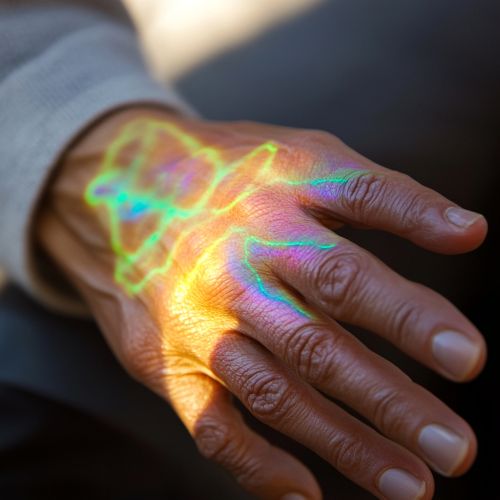Raynauds Disease - Secondary
Introduction
Raynaud's Disease, also known as Raynaud's Phenomenon, is a condition characterized by episodic vasospastic attacks that cause the blood vessels in the extremities, such as fingers and toes, to constrict. This article focuses on Secondary Raynaud's Disease, which is associated with other underlying health conditions.
Pathophysiology
Secondary Raynaud's Disease occurs due to an underlying medical condition that affects the blood vessels or connective tissues. The pathophysiology involves exaggerated vasoconstriction of the digital arteries and arterioles in response to cold or emotional stress. This vasospasm leads to reduced blood flow, causing the affected areas to turn white, blue, and then red as blood flow returns.
Etiology
Secondary Raynaud's Disease is often associated with autoimmune or connective tissue diseases. Common conditions linked to secondary Raynaud's include:
- Systemic lupus erythematosus (SLE)
- Scleroderma
- Rheumatoid arthritis
- Sjogren's syndrome
- Mixed connective tissue disease (MCTD)
Other potential causes include:
- Occupational hazards (e.g., vibration-induced white finger)
- Medications (e.g., beta-blockers, chemotherapy agents)
- Arterial diseases (e.g., atherosclerosis)
- Repetitive trauma or injury to the hands and feet
Clinical Manifestations
The clinical manifestations of Secondary Raynaud's Disease are similar to those of primary Raynaud's but tend to be more severe. Symptoms include:
- Triphasic color changes in the skin (white, blue, red)
- Numbness and tingling
- Pain and throbbing
- Ulcerations and sores in severe cases
The frequency and severity of attacks can vary widely among individuals.
Diagnosis
Diagnosis of Secondary Raynaud's Disease involves a thorough medical history and physical examination. Key diagnostic steps include:
- Nailfold capillaroscopy: This technique examines the capillaries at the base of the fingernail for abnormalities.
- Blood tests: These may include antinuclear antibodies (ANA), erythrocyte sedimentation rate (ESR), and specific autoantibodies to identify underlying autoimmune conditions.
- Cold stimulation test: This test assesses the vascular response to cold exposure.
Management
Management of Secondary Raynaud's Disease involves treating the underlying condition and alleviating symptoms. Strategies include:
- **Pharmacological Treatments:**
* Calcium channel blockers (e.g., nifedipine) to dilate blood vessels * Vasodilators (e.g., nitroglycerin ointment) * Alpha-blockers (e.g., prazosin) * Antiplatelet agents (e.g., aspirin) to reduce blood clot risk
- **Non-Pharmacological Treatments:**
* Avoiding cold exposure and wearing warm clothing * Stress management techniques * Smoking cessation to improve vascular health
- **Surgical Interventions:**
* Sympathectomy: A surgical procedure to cut nerves that cause blood vessel constriction * Digital sympathectomy: A less invasive procedure targeting specific fingers or toes


Complications
Secondary Raynaud's Disease can lead to several complications, particularly if the underlying condition is severe. Complications include:
- Digital ulcers and sores
- Infections due to poor blood flow
- Gangrene in extreme cases
- Permanent damage to blood vessels
Prognosis
The prognosis for individuals with Secondary Raynaud's Disease largely depends on the underlying condition. Early diagnosis and appropriate management of the associated disease can improve outcomes and reduce the frequency and severity of Raynaud's attacks.
Research and Future Directions
Ongoing research aims to better understand the mechanisms underlying Secondary Raynaud's Disease and develop more effective treatments. Areas of interest include:
- Genetic predisposition and molecular pathways
- Novel pharmacological agents targeting specific pathways
- Improved diagnostic techniques for early detection
See Also
References
- [Insert references here]
